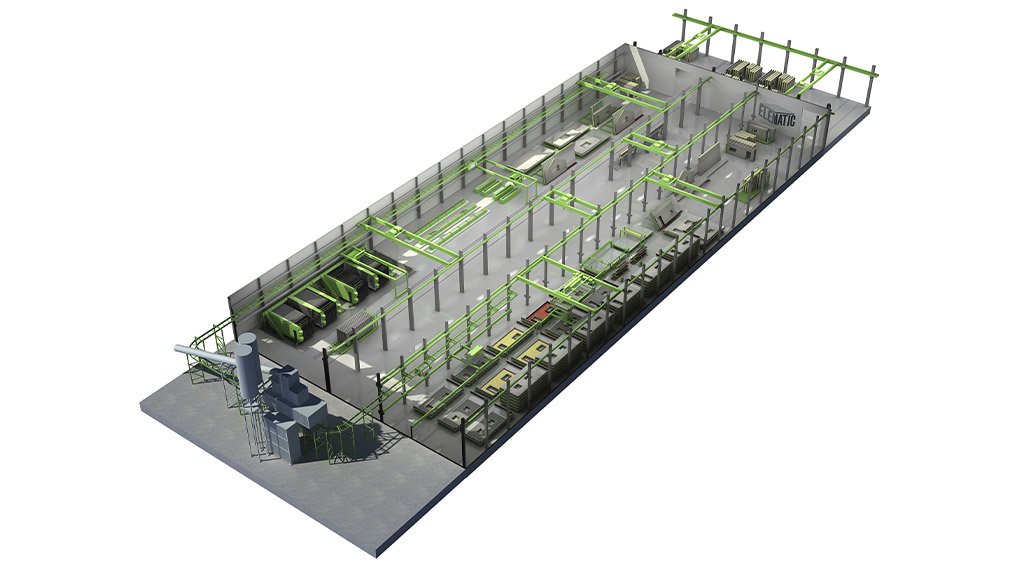What Makes An Efficient Precast Wall Production Line?
This article has been supplied as a media statement and is not written by Creamer Media. It may be available only for a limited time on this website.
Elematic is well-known globally for hollow core technology but the company also has a strong product line for precast wall element production, with three ready layout concepts – the SEMI, PRO and EDGE – depending on the amount of automation and production capacity needed.
But there are many other solutions available. “We have a wide range of other layout options for different capacities which have been proven to perform well in many existing factories. Our strength lies in our customized wall production solutions.” commented Toni Koitmaa, Product Director, Wall Technologies, Elematic, based in Finland.
A full range of wall manufacturing equipment
One device that seems to be making a huge difference in improving the efficiency of wall production lines is the central transfer wagon, especially when the product range includes both simple, fast moving elements and complex panels that require more production time. “The central wagon moves the elements that take more time to be fabricated away from the main line so bottlenecks in production are avoided. This allows the elements that are fabricated faster to move forward and makes production very flexible,” Koitmaa points out.
Pre-defined processes and proper documentation during the whole manufacturing process are important to ensure consistency in production and quality control. “Table moulds, for example, are a long-term investment. You have to ensure that the moulds can support the requirements set for the wall element. Table moulds have to be flat and straight and must withstand the load placed on them without bending. It takes a lot of expertise to make mould tables within strict tolerances,” Koitmaa says.
The casting machine is another crucial piece of equipment. Elematic’s Comcaster is, in Koitmaa’s words, “very unique, very accurate and fast,” while allowing for lower water-cement ratio. It can also cast stiffer grades of concrete than conventional casting machines and reduces surface finishing time.
Decreasing waste in the precast production process and improving cost-efficiency and safety are goals to keep in mind. “You can use half the usual amount of wood needed for table moulds, battery moulds and column- and pillar production by using the right shutter system. The FaMe system is comprised of push button magnets and aluminium side forms to replace wood and steel, which leads to substantial savings.” Koitmaa adds that the FaMe system was designed to improve work safety and lower the chances of finger injuries.
Battery moulds, which are used to cast solid load-bearing walls, can likewise have a big effect on efficiency. The cold shutter system, which is offered by very few equipment manufacturers in the industry, practically doubles the capacity of a standard battery mould. By transferring the cold shutter plates to the battery mould after the previously cast elements has been taken out, the casting cycle is significantly accelerated.
“The cold shutter system really speeds up the production cycle since only casting and hardening take place inside the battery mould. Using it is a great way to increase capacity,” Koitmaa explains.
Digitalisation also goes a long way towards reaching peak efficiency. “Using digital systems can help you get the maximum capacity from precast lines by optimising the process at different stages of production, leading to faster delivery time and saving on resources,” Koitmaa said. At this year’s BAUMA, Elematic launched the WallMES, as part of the digital Plant Control solution for precast plants.
Tried and tested on factory floors
Some examples of Elematic circulation lines in operation:
An Elematic production line is helping change the cityscape in the Nizhny Novgorod region in Russia. Karkas Monolit’s line has a capacity of 280 000 m2 per year, with 40 tables, three concrete transportation shuttles, a transfer wagon, a compaction station, a tilting station and a transport wagon. Their factory is the biggest in the region.
Norway’s Block Berge Bygg AS, whose production accounts for about 15 percent of the total concrete element market in Norway, has adopted an Elematic circulation line with an output 1500 m2 per week.
Finnish Santalan Betoni has also invested in Elematic’s circulation line for their new precast wall factory. The line includes, among others, 26 tables, a Comcaster E9 casting machine, tilting tables and two transfer wagons.
The Elematic Wall Production Lines
SEMI, for precast wall production between 70,000 to 150,000 m2 per year. SEMI Wall features straightforward and easy-to-learn basic technology.
- Theoretical capacity: 280-600 m2 / day (one casting)
- Personnel: 10
- Production area: 2000 m2
- Land area: 20000 m2
- No. of tables: 10-15
- Typical table size: 3.5 x 8.0 m
PRO, for precast production in the annual range of 170,000–300,000 m2. All the PRO key functions are automated. The PRO Wall line consists of a circulation line and optional battery molds and tilting tables.
- Theoretical capacity: 680–1200 m2 / day (one casting)
- Personnel: 12–20
- Production area: 2800 m2
- Land area: 45000 m2
- No. of tables: 20–30
- Typical table size: 3.8 x 9.0 m
EDGE, for very high capacity – in the annual range of 400,000–750,000 m2 – with a wide product range and highly automated precast production. The tables move automatically between the production steps for high productivity. Logistics are enhanced with a central transfer wagon that ensures smooth traffic. Productivity is further improved by a fully automated concrete transportation and an automatic shuttering station.
- Theoretical capacity: 1600–3024 m2 / day (one casting)
- Personnel: 30–35
- Production area: 9000 m2
- Land area: 70000 m2
- No. of tables: 40–60
- Typical table size: 4.0 x 10 m
Comments
Announcements
What's On
Subscribe to improve your user experience...
Option 1 (equivalent of R125 a month):
Receive a weekly copy of Creamer Media's Engineering News & Mining Weekly magazine
(print copy for those in South Africa and e-magazine for those outside of South Africa)
Receive daily email newsletters
Access to full search results
Access archive of magazine back copies
Access to Projects in Progress
Access to ONE Research Report of your choice in PDF format
Option 2 (equivalent of R375 a month):
All benefits from Option 1
PLUS
Access to Creamer Media's Research Channel Africa for ALL Research Reports, in PDF format, on various industrial and mining sectors
including Electricity; Water; Energy Transition; Hydrogen; Roads, Rail and Ports; Coal; Gold; Platinum; Battery Metals; etc.
Already a subscriber?
Forgotten your password?
Receive weekly copy of Creamer Media's Engineering News & Mining Weekly magazine (print copy for those in South Africa and e-magazine for those outside of South Africa)
➕
Recieve daily email newsletters
➕
Access to full search results
➕
Access archive of magazine back copies
➕
Access to Projects in Progress
➕
Access to ONE Research Report of your choice in PDF format
RESEARCH CHANNEL AFRICA
R4500 (equivalent of R375 a month)
SUBSCRIBEAll benefits from Option 1
➕
Access to Creamer Media's Research Channel Africa for ALL Research Reports on various industrial and mining sectors, in PDF format, including on:
Electricity
➕
Water
➕
Energy Transition
➕
Hydrogen
➕
Roads, Rail and Ports
➕
Coal
➕
Gold
➕
Platinum
➕
Battery Metals
➕
etc.
Receive all benefits from Option 1 or Option 2 delivered to numerous people at your company
➕
Multiple User names and Passwords for simultaneous log-ins
➕
Intranet integration access to all in your organisation





















